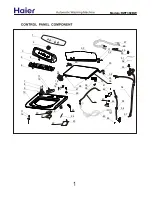
15
■
Bottom rack does not fully slide into the dishwasher
Check to see if items loaded for ™ wash option have shifted.
Reload to keep items from interfering with spray jets or spray
arm.
Dishes do not dry completely
■
Dishes do not dry completely
Did you use a rinse aid? Your dishwasher is designed to use
rinse aid for good drying performance. Without rinse aid your
dishes and dishwasher interior will have excessive moisture.
The heat dry option will not perform as well without rinse aid.
■
Dishes are not dry
Did you load your dishwasher to allow proper water drainage?
Do not overload. Use a liquid rinse aid to speed drying.
Are the plastics wet? Plastics often need towel drying.
Is the rinse aid dispenser empty?
Did you use an air-dry or energy-saving dry option? Use a
heated drying option for dryer dishes.
■
Excess moisture on racks and dishwasher interior
Check the rinse aid indicator to see that there is rinse aid in the
dispenser.
Spots and stains on dishes
■
Spotting and filming on dishes
Is your water hard, or is there a high mineral content in your
water? Conditioning the final rinse water with a liquid rinse aid
helps eliminate spotting and filming. Keep the rinse aid
dispenser filled. Always use a high-temp option. If your water
hardness is 13 grains or above, it is strongly recommended that
you install a home water softener. If you do not wish to drink
softened water, have the softener installed onto your hot water
supply.
Is the water temperature too low? For best dishwashing results,
water should be 120°F (49°C) as it enters the dishwasher.
Did you use the correct amount of effective detergent? Use
recommended dishwasher detergents only. Do not use less
than 1 tbs (15 g) per load. Detergent must be fresh to be
effective. Heavy soil and/or hard water generally require extra
detergent.
Using dishwasher detergent tablets and packs have been
proven better than powder, liquid or gel detergents to reduce
filming on your dishes. By using these tablets and packs, over
time this will start to reduce or eliminate white film. Also, by
using a rinse aid you can minimize repeat buildup of white film.
Is the home water pressure high enough for proper dishwasher
filling? Home water pressure should be 20 to 120 psi (138 to
828 kPa) for proper dishwasher fill. If you have questions about
your water pressure, call a licensed, qualified plumber.
NOTE: To remove spots and film from glassware, remove all
silverware and metal items and run a vinegar rinse as described
in “Dishwasher Care.”
■
Silica film or etching (silica film is a milky, rainbow-colored
deposit; etching is a cloudy film)
Sometimes there is a water/chemical reaction with certain
types of glassware. This is usually caused by some
combination of soft or softened water, alkaline washing
solutions, insufficient rinsing, overloading the dishwasher, and
the heat of drying. It might not be possible to avoid the
problem, except by hand washing.
To slow this process use a minimum amount of detergent but
not less than 1 tbs (15 g) per load. Use a liquid rinse aid and
underload the dishwasher to allow thorough rinsing. Silica film
and etching are permanent and cannot be removed. Do not use
heated drying.
■
White spots on cookware with nonstick finish
Has the dishwasher detergent removed cookware seasoning?
Reseason cookware after washing it in the dishwasher.
■
Brown stains on dishes and dishwasher interior
Does your water have high iron content? Rewash dishes using
1-3 tsp (5-15 mL) of citric acid crystals added to the covered
section of the detergent dispenser. Do not use detergent.
Follow with a Normal wash cycle with detergent. If treatment is
needed more often than every other month, the installation of
an iron removal unit is suggested.
■
Black or gray marks on dishes
Are aluminum items rubbing dishes during washing?
Disposable aluminum items can break down in the dishwasher
and cause marking. Hand wash these items. Remove
aluminum markings by using a mild abrasive cleaner.
■
Orange stains on plastic dishes or dishwasher interior
Are large amounts of tomato-based foods on dishes placed in
the dishwasher? It may be necessary to use a stain removal
product to remove stains from your dishwasher. Stains will not
affect dishwasher performance.
Noises
■
Surging sounds
Surging sounds can occur periodically throughout the cycle
while the dishwasher is draining
■
Valve hissing
Normal water valve hissing may be heard periodically, during
the water fill.
■
Snapping sound
A normal snap sound may be heard when the detergent
dispenser opens during the cycle, and when the door is
opened at the end of the cycle.
■
Grinding, grating, crunching or buzzing sounds
A hard object has entered the wash module (on some models).
When the object is ground up, the sound should stop. If the
noise persists after a complete cycle, call for service.
Dishwasher Stops and starts
■
Numerous starts and stops
It is normal to hear numerous starts and stops during
throughout your entire cycle. These Starts and stops are
needed to provide optimal cleaning performance and energy
savings.
■
Depending on cycle selected
Depending on the cycle selected and the soil level sensed by
the “Optical Water Sensor” (In some models) you will
experience more starts and stops throughout the entire cycle.
Содержание DISHWASHER
Страница 4: ...4 Parts and Features ...
Страница 21: ...21 Piezas y características ...
Страница 38: ...38 Pièces et caractéristiques ...
Страница 52: ...W10656408B 2014 Whirlpool Tous droits réservés 9 14 Imprimé aux É U ...
















































